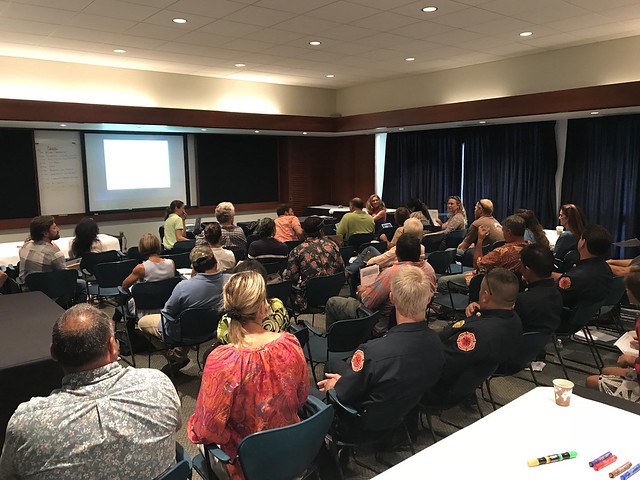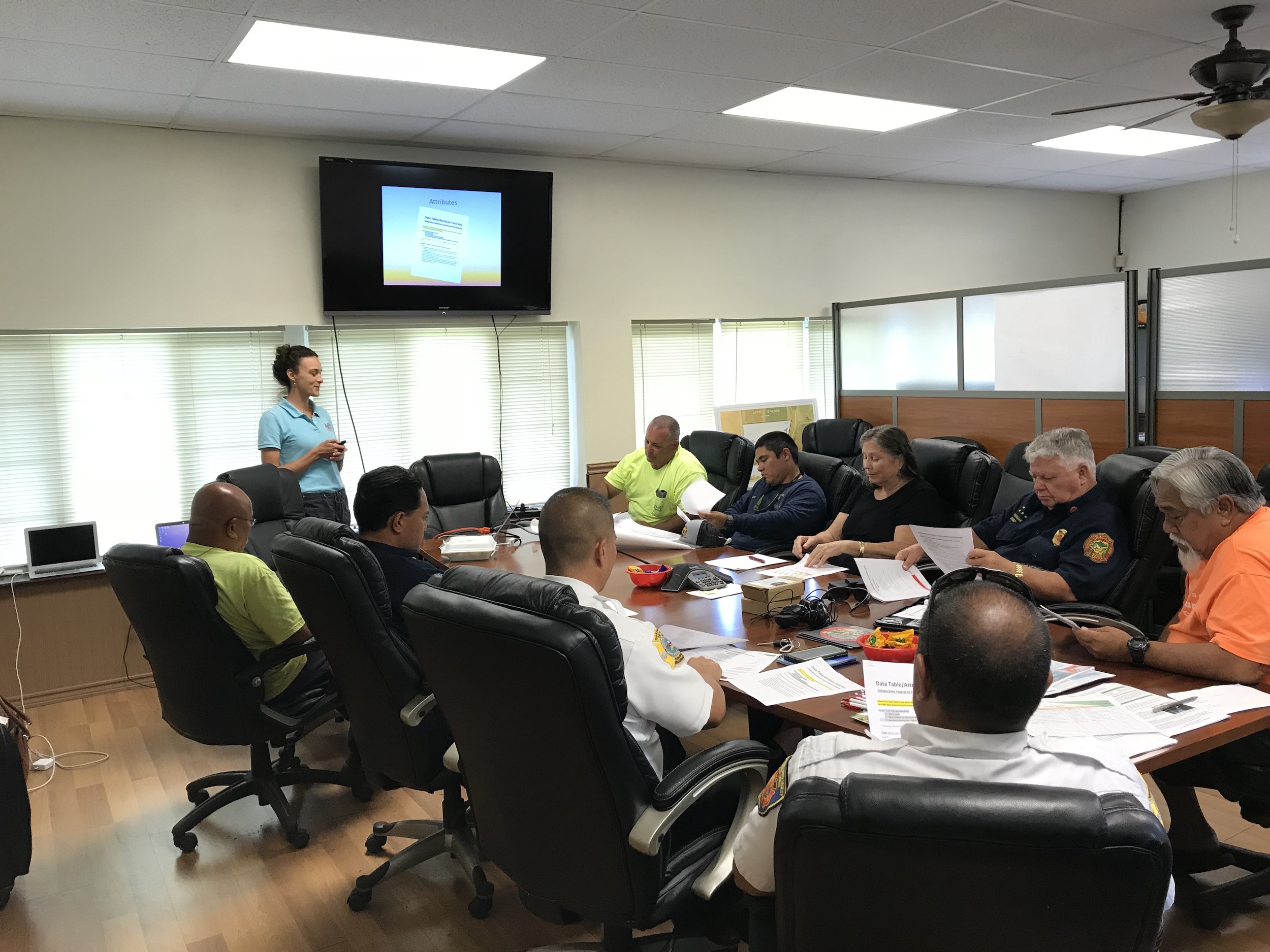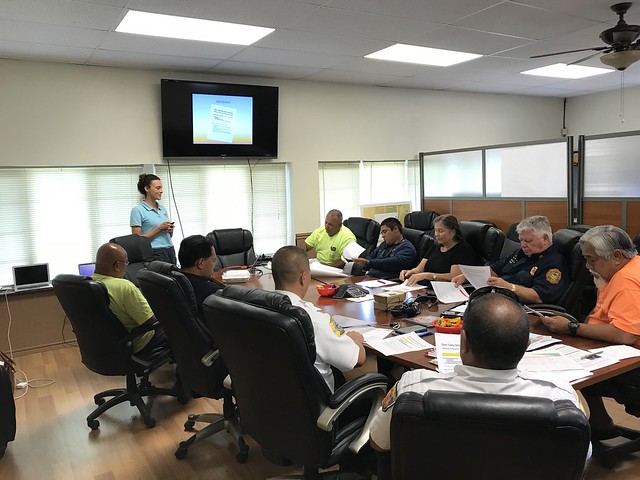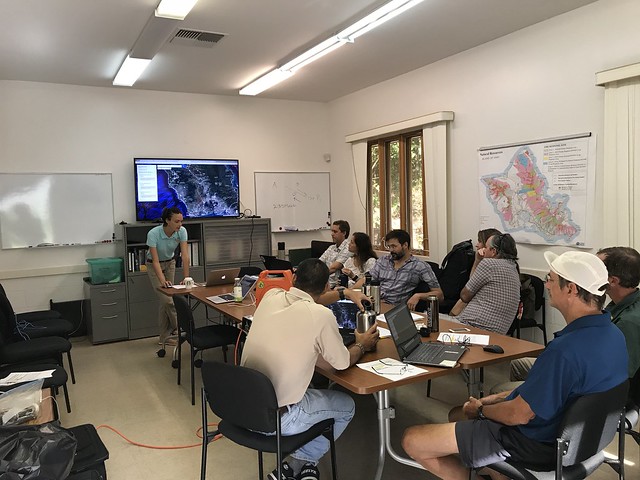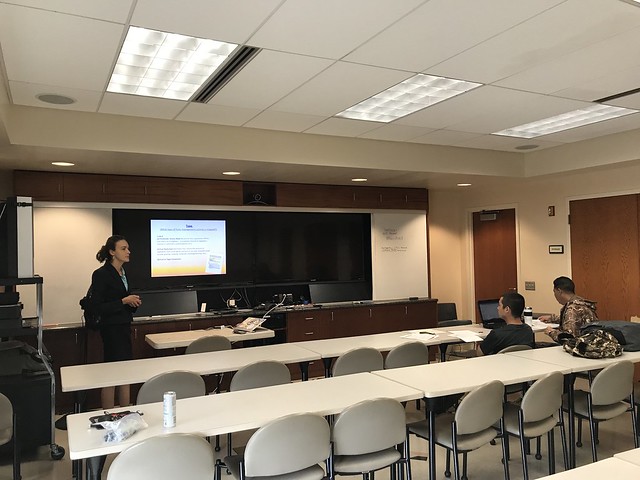The August wildfire that burned 18,000 acres (2nd largest in recent Hawaii history) near Waikoloa was a close call for community members. Communications from agencies to residents were a challenge and a hot topic (pun intended) at the Waikoloa Firewise Community Forum on September 27. More than 50 residents and a number of speakers representing various agencies and legislative offices were present to recap the pluses and minuses of the response to the massive wildfire. Thank you to Waikoloa Fire Management Action Committee for inviting HWMO and putting together this successful event!
Maui Vegetative Fuels Management Collaborative Action Planning Workshop
Full house for the workshop!
As a hub of wildfire protection efforts across the Hawaiian Islands, we are always looking for ways to bring people together to solve some of our most complex wicked problems. The Hawaiian Islands have been struggling with invasive species spread for decades, but now we are seeing what happens when invasive flammable plants take over the landscape and allow fires to spread more quickly and over larger areas. By controlling or managing flammable vegetation at the landscape-level, we can make great strides towards reducing the wildfire risk on our islands.
That’s why HWMO is coordinating a statewide vegetative fuels management mapping project — a rapid assessment to understand the vegetation management needs and priorities of landowners and land managers throughout the Hawaiian Islands. DLNR Division of Forestry and Wildlife and University of Hawaii CTAHR Cooperative Extension are key partners in the effort.
The vision for the project is that the resulting maps will lead to 1) better prioritization and communication of vegetative fuels management on the landscape-scale and 2) enhance project coordination between organizations and funding opportunities.
Marking areas of importance to protect from wildfires.
Discussing collaborative project ideas.
As part of the next phase of our groundbreaking project, we held a collaborative action planning workshop at the Maui Arts and Culture Center in Kahului. Nearly 50 participants representing a wide variety of fields and backgrounds came together to discuss what future landscape-level vegetation management projects could be on the horizon. During breakout group sessions, teams of people circulated to different tables to highlight key areas for protection, helping inform us on the top priority areas for the last part of the workshop: outlining actual project ideas. Additionally, and possibly more importantly, many people were able to meet new faces, share ideas, and became new work partners. HWMO truly is a hub!
Kauai Vegetative Fuels Management Mapping Workshop with KAA
Mapping with KAA members, Navy, and Kauai Fire Department on the west side of Kauai.
As a hub of wildfire protection efforts across the Hawaiian Islands, we are always looking for ways to bring people together to solve some of our most complex wicked problems. The Hawaiian Islands have been struggling with invasive species spread for decades, but now we are seeing what happens when invasive flammable plants take over the landscape and allow fires to spread more quickly and over larger areas. By controlling or managing flammable vegetation at the landscape-level, we can make great strides towards reducing the wildfire risk on our islands.
That’s why HWMO is coordinating a statewide vegetative fuels management mapping project — a rapid assessment to understand the vegetation management needs and priorities of landowners and land managers throughout the Hawaiian Islands. DLNR Division of Forestry and Wildlife and University of Hawaii CTAHR Cooperative Extension are key partners in the effort.
The vision for the project is that the resulting maps will lead to 1) better prioritization and communication of vegetative fuels management on the landscape-scale and 2) enhance project coordination between organizations and funding opportunities.
On September 26, we partnered with Kekaha Agriculture Association for a workshop to map current and desired vegetation management activities in Kekaha on the west side of Kauai (where most of the island’s most devastating wildfires have occurred). Activities could include any vegetation reduction or conversion projects such as roadside mowing, fuelbreaks, grazing rotations, clearing around structures or power poles, brush abatement or thinning, tree trimming, loi restoration, agriculture, and native forest restoration. Mahalo KAA for hosting the workshop and for participating in this critical project!
Oahu Vegetative Fuels Management Mapping Workshops with DOFAW and WMWP
Mapping in action!
As a hub of wildfire protection efforts across the Hawaiian Islands, we are always looking for ways to bring people together to solve some of our most complex wicked problems. The Hawaiian Islands have been struggling with invasive species spread for decades, but now we are seeing what happens when invasive flammable plants take over the landscape and allow fires to spread more quickly and over larger areas. By controlling or managing flammable vegetation at the landscape-level, we can make great strides towards reducing the wildfire risk on our islands.
That’s why HWMO is coordinating a statewide vegetative fuels management mapping project — a rapid assessment to understand the vegetation management needs and priorities of landowners and land managers throughout the Hawaiian Islands. DLNR Division of Forestry and Wildlife and University of Hawaii CTAHR Cooperative Extension are key partners in the effort.
The vision for the project is that the resulting maps will lead to 1) better prioritization and communication of vegetative fuels management on the landscape-scale and 2) enhance project coordination between organizations and funding opportunities.
On September 25, we joined up with DOFAW and Waianae Mountains Watershed Partnership (WMWP) for back-to-back workshops to map current and desired vegetation management activities on Oahu. Activities could include any vegetation reduction or conversion projects such as roadside mowing, fuelbreaks, grazing rotations, clearing around structures or power poles, brush abatement or thinning, tree trimming, loi restoration, agriculture, and native forest restoration. The workshop took place at the DOFAW Makiki office at the foot of the beautiful Makiki Valley.
Hilo Vegetative Fuels Management Mapping Workshop with DOFAW
Mapping with DOFAW representatives in Hilo.
As a hub of wildfire protection efforts across the Hawaiian Islands, we are always looking for ways to bring people together to solve some of our most complex wicked problems. The Hawaiian Islands have been struggling with invasive species spread for decades, but now we are seeing what happens when invasive flammable plants take over the landscape and allow fires to spread more quickly and over larger areas. By controlling or managing flammable vegetation at the landscape-level, we can make great strides towards reducing the wildfire risk on our islands.
That’s why HWMO is coordinating a statewide vegetative fuels management mapping project — a rapid assessment to understand the vegetation management needs and priorities of landowners and land managers throughout the Hawaiian Islands. DLNR Division of Forestry and Wildlife (DOFAW) and University of Hawaii CTAHR Cooperative Extension are key partners in the effort.
The vision for the project is that the resulting maps will lead to 1) better prioritization and communication of vegetative fuels management on the landscape-scale and 2) enhance project coordination between organizations and funding opportunities.
On September 18, we linked up with DOFAW for a workshop in Hilo to map current and desired vegetation management activities. Activities could include any vegetation reduction or conversion projects such as roadside mowing, fuelbreaks, grazing rotations, clearing around structures or power poles, brush abatement or thinning, tree trimming, loi restoration, agriculture, and native forest restoration.
Waikii Ranch 2nd Annual Firewise BBQ
Education is fun — and definitely when food is involved! For the 2nd straight year, Waikii Ranch held a Firewise BBQ for its members as part of their Firewise Communities efforts. HWMO was invited as one of several wildfire speakers, sharing information on wildfire preparedness (Firewise, ReadySetGo!, etc.) and the latest updates about HWMO.
Waikii Ranch has been a Firewise Community since 2017 and are working towards a 2nd year as a nationally-recognized site. We know they can do it!
Maui Vegetative Fuels Management Mapping Meetings and LHWRP Workshop
Mapping with Lance De Silva of DOFAW.
As a hub of wildfire protection efforts across the Hawaiian Islands, we are always looking for ways to bring people together to solve some of our most complex wicked problems. The Hawaiian Islands have been struggling with invasive species spread for decades, but now we are seeing what happens when invasive flammable plants take over the landscape and allow fires to spread more quickly and over larger areas. By controlling or managing flammable vegetation at the landscape-level, we can make great strides towards reducing the wildfire risk on our islands.
That’s why HWMO is coordinating a statewide vegetative fuels management mapping project — a rapid assessment to understand the vegetation management needs and priorities of landowners and land managers throughout the Hawaiian Islands. DLNR Division of Forestry and Wildlife and University of Hawaii CTAHR Cooperative Extension are key partners in the effort.
The vision for the project is that the resulting maps will lead to 1) better prioritization and communication of vegetative fuels management on the landscape-scale and 2) enhance project coordination between organizations and funding opportunities.
Mapping at the LHWRP office with members of the ranching community on Maui.
On June 16 and 17, we had a series of meetings with DOFAW, Alexander & Baldwin, Hana Ranch, and DHHL to map current and desired vegetation management activities in Maui Nui. Activities could include any vegetation reduction or conversion projects such as roadside mowing, fuelbreaks, grazing rotations, clearing around structures or power poles, brush abatement or thinning, tree trimming, loi restoration, agriculture, and native forest restoration. On June 18, we held a workshop in conjunction with Leeward Haleakala Watershed Partnership to gather more data, especially in regards to restoration efforts and grazing areas.
Waialea Community Fuelbreak July 2018 Maintenance
Waialea has been a Firewise Community since 2016, but they have been working towards wildfire prevention solutions in their small community for several years prior to then. The community fuelbreak, initially created through financial and technical support from HWMO, has been consistently kept maintained by the community since HWMO handed the reigns over. Take a look at the great work they did this July to keep their fuelbreak maintained as a last line of defense for firefighters to protect the shoreline community.
Photo credits: Bill White, Waialea Firewise committee chair
Ocean Warriors Wildfire Education at Puako
It’s all about making learning fun!
HWMO once again teamed up with Malama Kai Foundation’s Ocean Warriors program to educate middle school students about wildfire issues and solutions. The Ocean Warriors program is a youth environmental engagement and empowerment program that has kids become directly involved in projects, be a part of bigger solutions, raise money toward open space protection, and save vulnerable wild spaces, including those vulnerable to wildfire.
At Paniau Beach in Puako, the kids learned from HWMO staff (Elizabeth, Tom, Orlando, Melissa) the importance of preventing wildfire in order to protect the entire watershed from summit to sea.
Puukapu Pastoral Firewise Assessment Review Meeting
The review team — mahalo everyone!
Wildfire protection takes collaboration. We had a very fruitful meeting with Puukapu Pastoral residents, Department of Hawaiian Home Lands, Hawaii Fire Department, and Natural Resources Conservation Service representatives. Together, we brainstormed actions Puukapu lessees, with assistance from their partners, could take to create a safer Firewise and tighter-knit community. HWMO works as a hub to connect people because collaboration truly is the most effective way to see immediate and long-lasting results. Big mahalo to all who participated and for the residents taking charge to be pioneers in their community and showing real leadership and determination to protect the families and beautiful lands of Puukapu.





